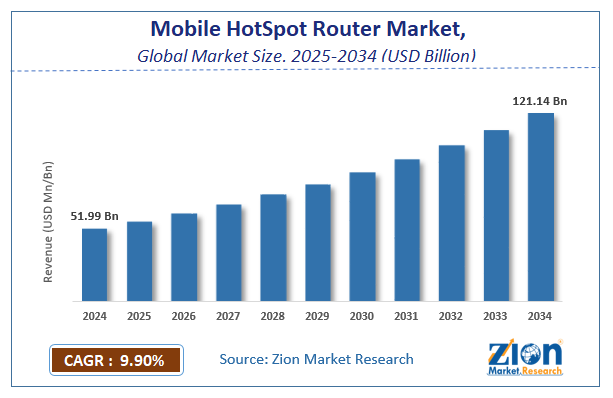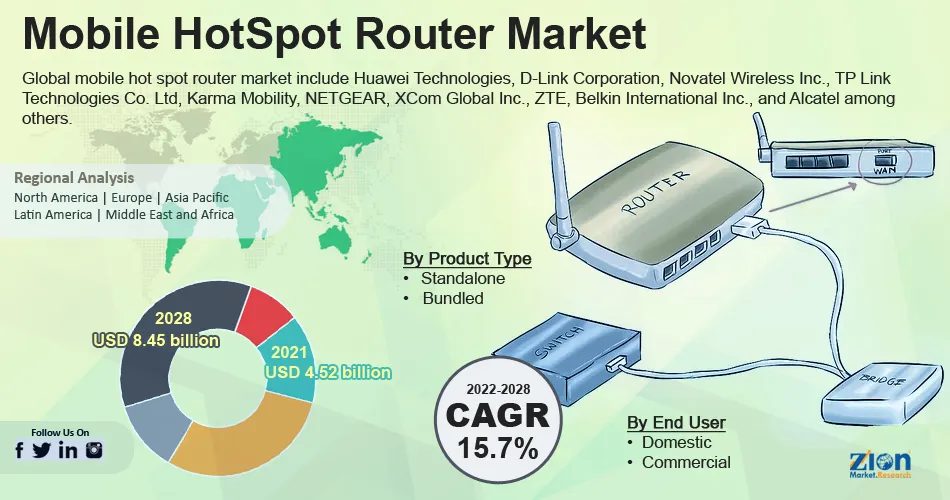Mobile HotSpot Router Market Size, Analysis & Outlook 2028

Mobile HotSpot Router Market By Product Type (Standalone and Bundled), By End-user (Domestic and Commercial), and By Region - Global and Regional Industry Overview, Market Intelligence, Comprehensive Analysis, Historical Data and Forecasts 2022 - 2028
| Market Size in 2021 | Market Forecast in 2028 | CAGR (in %) | Base Year |
|---|---|---|---|
| USD 4.52 Billion | USD 8.45 Billion | 15.7% | 2021 |
Global Mobile HotSpot Router Industry Prospective:
The global mobile hot spot router market size registered a revenue growth of USD 4.52 billion in 2021 and is predicted to increase to around USD 8.45 billion by 2028, with a compound annual growth rate (CAGR) of around 15.7 % throughout the forecast period. The study examines the drivers and restraints in the mobile hot spot router market, as well as their impact on demand throughout the forecast period. The report also looks at new potential in the mobile hot spot router industry.
Mobile Hot Spot Router Market: Overview
A mobile hotspot router is a small wireless device that allows several Wi-Fi-compatible devices to connect to a single router. The routers are generally built as standalone portable gadgets that can be connected to the phone and are equipped with several features such as a USB point, power bank, and global positioning system.
They offer simple, quick, and rapid internet access to a variety of devices, including laptops, mobile phones, and PCs, which can be used at any time. They also provide numerous customers with high-speed internet access at the same time, lowering the aggregate cost of internet services.
Mobile Hot Spot Router Market: Growth Drivers
A rapid surge in smartphone users supports the strong growth of the market.
Mobile technology has significantly expanded around the world. Over 4.5 billion individuals are projected to own mobile devices today, with smartphones accounting for more than half of these connections. Younger individuals, those with better levels of education, and those with higher earnings seem to be more inclined to be digitally connected, whether in established or emerging countries.
Younger individuals are far more likely to have smartphones that have good internet access and connectivity for better use of social media and other work activities.
Mobile Hot Spot Router Market: Restraints
Issues with network preference and low connectivity may hinder market growth.
Slow Wi-Fi is inconvenient, especially during studying or working remotely. A slow internet connection may make or break your day, whether you need to transfer work-related files to the cloud or stream a favorite online show. Mobile hotspot routers can break down due to many reasons which can halt any work depending on the internet.
These failures may be frequency interference from other wireless devices, physical obstructions, or mismatched router and adapter settings. However, the frequent occurrence of these failures forced customers to shift to another internet source or LAN which can reduce the sale of mobile hotspot routers in the market.
Mobile Hot Spot Router Market: Opportunities
Increasing work-from-home culture is likely to offer better growth opportunities for market expansion.
Many businesses are using telework (working from home) on a wide scale as an essential physical distancing measure due to continuous health and economic problems caused by the COVID-19 outbreak. This might help to accelerate the adoption of remote work practices even after the crisis has passed. For most firms, it has now become the standard practice that 70% of the workers will be working from home at least five days a month by 2025, according to the latest estimates.
These factors are expected to support the use of mobile hotspot routers during the forecast period. Also, multiple options available in the market with different prices range is expected to increase the growth of the global mobile hot spot router market during the forecast period.
Mobile Hot Spot Router Market: Challenges
Low spending power in low-income countries poses a major challenge to market growth.
The Internet penetration rate in low-income countries is still emergent, also the spending power of the customers on the Internet is comparatively very low which directly affects the penetration of advanced Internet access devices.
In addition to this, most of these countries are still suffering the post-pandemic economic crises which is why governments in these countries are still lacking funds to strengthen the 4G network with full capacities. Moreover, the dearth of manufacturers and distributors in these countries further hinders the expansion of the market.
Mobile HotSpot Router Market: Report Scope
| Report Attributes | Report Details |
|---|---|
| Report Name | Mobile HotSpot Router Market |
| Market Size in 2021 | USD USD 4.52 Billion |
| Market Forecast in 2028 | USD USD 8.45 Billion |
| Growth Rate | CAGR of 15.7% |
| Number of Pages | 172 |
| Key Companies Covered | Huawei Technologies, D-Link Corporation, Novatel Wireless Inc., TP Link Technologies Co. Ltd, Karma Mobility, NETGEAR, XCom Global Inc., ZTE, Belkin International Inc., Alcatel, |
| Segments Covered | By Product, By End User and By Region |
| Regions Covered | North America, Europe, Asia Pacific (APAC), Latin America, Middle East, and Africa (MEA) |
| Base Year | 2021 |
| Historical Year | 2016 to 2020 |
| Forecast Year | 2022 - 2028 |
| Customization Scope | Avail customized purchase options to meet your exact research needs. Request For Customization |
Mobile Hot Spot Router Market: Segmentation
The global mobile hot spot router market is categorized based on product type, end-user, and region.
Based on product type, the market is categorized into standalone and bundled.
Based on end-user, segment of the market is bifurcated into domestic and commercial. Among the end users, the domestic segment leads the market with over 65 percent of the share.
Recent Developments
- July 2021, El Pas, the most-rated Spanish daily online, has rated the TP-Link® 4G LTE Mobile Wi-Fi Hotspot, M7000, as the finest portable MiFi hotspot. M7000 received an 8.75 out of 10 from the publication, making it the best of the five hotspots.
- January 2020, at CES 2020, Linksys, the connected home business of Belkin International and Foxconn Interconnect Technology (FIT), presented a portfolio of new 5G products for the home and workplace.
Mobile Hot Spot Router Market: Regional Landscape
Asia Pacific to lead the global market during the forecast period.
Asia Pacific is expected to hold a major share of the global mobile hotspot router market. This is attributed to a large customer base in China & India, increasing internet services across the cities, the presence of top manufacturers, and government initiatives to strengthen network coverage. A large number of students have enrolled in higher education in China. China's high-technology curricula are seen as an advantage to the country's research and development capabilities, assisting its workers in transforming into a high-value workforce. The number of fixed and mobile broadband subscriptions in the nation has increased significantly.
Also, the Chinese government intends to provide broadband connectivity in around 98 percent of the country's villages. All of these variables point to a consistent increase in the country's Wi-Fi analytics industry. North America remains the second-largest revenue-contributing region in the global market. The increasing use of high-speed internet for entertainment, advertisement, and office work is largely contributing to the growth of the market in this region.
Mobile Hot Spot Router Market: Competitive Landscape
Major players functioning in the global mobile hot spot router market include;
- Huawei Technologies
- D-Link Corporation
- Novatel Wireless Inc.
- TP Link Technologies Co. Ltd
- Karma Mobility
- NETGEAR
- XCom Global Inc.
- ZTE
- Belkin International Inc.
- Alcatel
The global mobile hot spot router market is segmented as follows:
By Product Type
- Standalone
- Bundled
By End User
- Domestic
- Commercial
By Region
- North America
- The U.S.
- Canada
- Europe
- France
- The UK
- Spain
- Germany
- Italy
- Rest of Europe
- Asia Pacific
- China
- Japan
- India
- South Korea
- Southeast Asia
- Rest of Asia Pacific
- Latin America
- Brazil
- Mexico
- Rest of Latin America
- Middle East & Africa
- GCC
- South Africa
- Rest of Middle East & Africa
Table Of Content
Methodology
FrequentlyAsked Questions
Rapid surge in smartphone users supporting the strong growth of the market. Mobile technology has significantly expanded around the world. Over 4.5 billion individuals are projected to own mobile devices today, with smartphones account for more than half of these connections. Younger individuals, those with better levels of education, and those with higher earnings seem to be more inclined to be digitally connected, whether in established or emerging countries.
According to the Zion Market Research report, the global mobile hot spot router market was worth about 4.52 (USD billion) in 2021 and is predicted to grow to around 8.45 (USD billion) by 2028, with a compound annual growth rate (CAGR) of around 15.7 percent.
Asia Pacific is expected to hold the major share in the global mobile hotspot router market. This is attributed to a large customer base in China and India, increasing internet services across the cities, the presence of top manufacturers, and government initiatives to strengthen the network coverage.
Major players functioning in the global mobile hot spot router market include Huawei Technologies, D-Link Corporation, Novatel Wireless Inc., TP Link Technologies Co. Ltd, Karma Mobility, NETGEAR, XCom Global Inc., ZTE, Belkin International Inc., and Alcatel among others.
Choose License Type
List of Contents
Global Industry Prospective:Mobile Hot Spot Router OverviewMobile Hot Spot Router Growth DriversMobile Hot Spot Router RestraintsMobile Hot Spot Router ChallengesReport ScopeMobile Hot Spot Router SegmentationRecent DevelopmentsMobile Hot Spot Router Regional LandscapeMobile Hot Spot Router Competitive LandscapeRelatedNews
HappyClients
Zion Market Research
Tel: +1 (302) 444-0166
USA/Canada Toll Free No.+1 (855) 465-4651
3rd Floor,
Mrunal Paradise, Opp Maharaja Hotel,
Pimple Gurav, Pune 411061,
Maharashtra, India
Phone No +91 7768 006 007, +91 7768 006 008
US OFFICE NO +1 (302) 444-0166
US/CAN TOLL FREE +1 (855) 465-4651
Email: sales@zionmarketresearch.com
We have secured system to process your transaction.
Our support available to help you 24 hours a day, five days a week.
Monday - Friday: 9AM - 6PM
Saturday - Sunday: Closed







